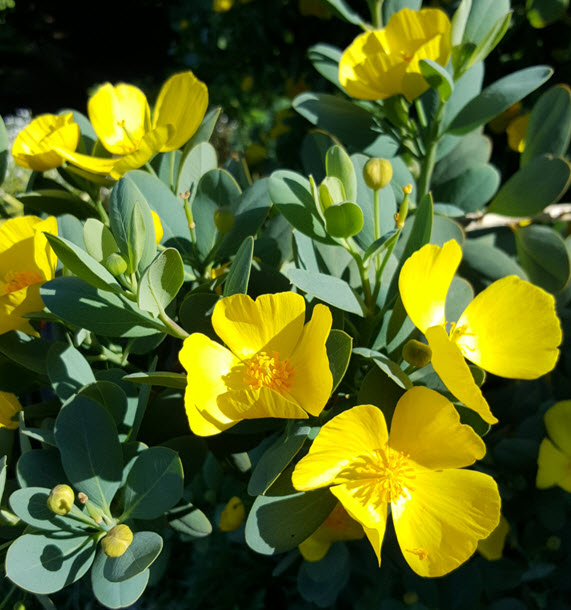A great selection of flowering plants this month
There are just so many superb plants bursting forth into the warmth of spring this month it will be impossible to detail them all, you will just have to come in and see them all for yourself. Here is a small selection to wet your appetite.
Spectacular Bootlace
Our Pimelea nivea is looking fantastic at the moment! The small heads of white flowers cover the tops of the plant and are really accentuated by the small dark green and glossy leaves beneath. This native Tasmanian plant is a treasure to have in the garden and it is tolerant of a range of soils as long as they are well drained and have good moisture holding through the drier months. They are in in the same family as Daphne and often tolerate the same growing conditions. Organic mulches are important to keep this plant looking great. Light tip pruning after flowering will help this plant stay compact and full of bloom each year. It is such a good plant for the small yard and also does well in medium to large containers. Pimelea nivea can be found in specialist native nurseries and occasionally in local retail centre’s. We have some specimens growing around the Derwent river side of the Visitor Centre and in the native area of the Gardens.
Climbing beauty
Climbing in amongst the other shrubs near the Visitor Centre, the Native Clematis, Clematis aristata is making a spectacular show. This delightful and relatively simple plant to grow is at home twining through other plants. It is a light climber and does not make too much of an impact on the other shrubs with only the occasional redirection of a shoot by our horticulturists. This is probably one of the best examples of how you can grow this plant at home.
Red flowering stunner!
One of the most striking of the New Zealand endemic plants the Metrosideros fulgens or Scarlet Rata Vine, Māori akatawhiwhi. At home in both semishade and full sun, it has self clinging roots that help it climb the roughest surfaces. This one is in fill bloom and just down from the visitor centre on the path towards the floral clock. There are more up near the education pod on the rear of the toilet block behind the glasshouse, see if you can find them.
The Rhododendrons are still flowering!
There are still many magnificent Rhododendrons in full flower including a number of the so called tropical Rhododendrons. The tag ‘tropical’ comes from the fact that many of these plants come from tropical areas of the world, however their habitat is often the highland areas, at altitude, and therefore these environments are mostly cooler with high rainfall and mists. In many ways their native habitats are similar to the conditions found in parts of Tasmania. Find these amongst the trees and shrubs around the lower garden near the Anniversary arch.

A Tree Poppy or Bush Poppy in The Friends Mixed Border
Tree Poppy, Bush Poppy – Papaveracea / Notes from principle horticulturist of the Friends Mixed Border Anne Griffin
Dendromecon harfordii – This species is found on Santa Rosa, Santa Cruz, and Santa Catalina Islands off the coast of southern California. It is a rangy evergreen shrub clothed with grey-green oval leaves. The branches are brittle and can break in strong winds. The shrub takes well to a prune after flowering which is necessary to maintain a compact shape. It produces an abundance of medium sized yellow poppy flowers at the growing tips of new growth from mid-spring into summer. Its natural habit is to reach up to 2 metres x 2 metres.
It requires a location which receives full sun to part shade in well-draining soil. Drought tolerant once established. Our plant is established near the end of the Eardly- Wilmott Wall of the perennial border near the Derwent river side; it is looking stunning and well worth a visit!
Iris bed full of bud and ready to burst! / Notes from principle horticulturist of the Friends Mixed Border Anne Griffin
The Iris bed was renovated and planted up with Iris germanica cultivars in 2011. The Iris are at their best from mid-October every year, with the peak bloom about to occur now. The scent of the Iris is very strong and beautiful. Complementing the Iris planting are shrub roses and Dianthus plumaris cascading over the front edge of the retaining wall. New growth of the Miscanthus sacchariflorus has just started (Amur Silver Grass). This upright columnar grass reaches over 2 metres and gently sways in the breeze. Children love to sit on the stone path at its feet listening to the rustling of the leaves.

Older posts worth looking at:





